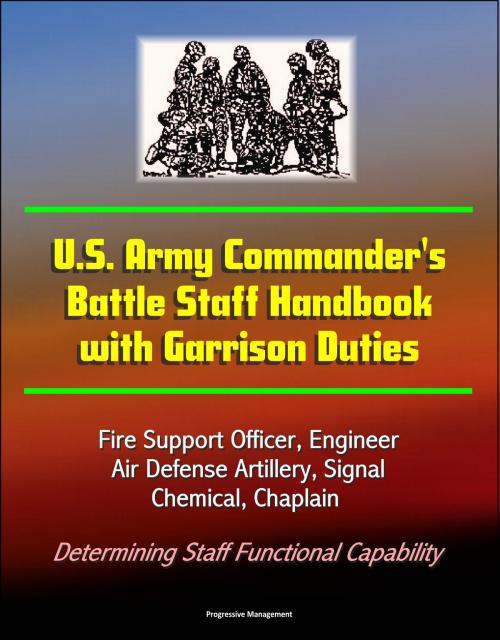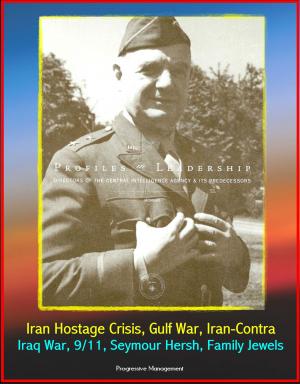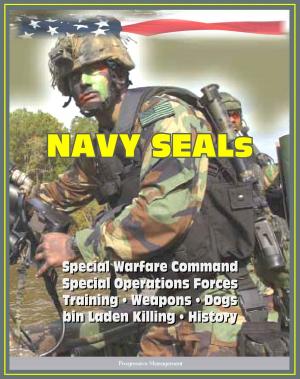U.S. Army Commander's Battle Staff Handbook with Garrison Duties: Fire Support Officer, Engineer, Air Defense Artillery, Signal, Chemical, Chaplain - Determining Staff Functional Capability
Nonfiction, History, Military, United States| Author: | Progressive Management | ISBN: | 9781310979620 |
| Publisher: | Progressive Management | Publication: | January 18, 2015 |
| Imprint: | Smashwords Edition | Language: | English |
| Author: | Progressive Management |
| ISBN: | 9781310979620 |
| Publisher: | Progressive Management |
| Publication: | January 18, 2015 |
| Imprint: | Smashwords Edition |
| Language: | English |
This Research Product, prepared for the Deputy Commanding General for Training, U.S. Army Combined Arms Command, Fort Leavenworth, Kansas, presents information for the maneuver battalion commander and staff to consider. It provides information to determine staff functional capability, assess staff actions, and provide fundamental references for inexperienced staff officers. It describes the core duties of battalion staff officers and key slice liaison officers on the battle staff.
Feedback from field commanders, combat training center (CTC) observations, and research conducted by the Training Systems Research Division of the U.S. Army Research Institute for the Behavioral and Social Sciences supports the need for staff training at the battalion level. The results of this effort have been published in ARI Research Report 1607 (December 1991) Battle Staff Training and Synchronization in Light Infantry Battalions and Task Forces. Current officer training programs do not systematically provide necessary functional area skills. The Commander's Battle Staff Handbook serves as an interim tool to meet this critical requirement. The handbook is a reference document, not a complete training program. It can serve as the battalion commander's guide to staff functional duties in combat preparation. It can also be used to give the battalion's new staff officers a starting point to learn their own garrison responsibilities since functional area references are provided. This handbook cannot replace functional area skills training and the valuable experience acquired during staff and field exercises. It can, however, be the supportive first step for the enthusiastic staff officer who lacks initial knowledge and comprehension about his duties.
PREFACE * INTRODUCTION * To The Commander * To The Commander and Staff * Purpose * Organization * Level of Detail * Checklists * XO * CSM * S1 * S2/BICC * S3/S3 * Air * S4/BMO * Fire Support Officer * Engineer * Air Defense Artillery * Signal * Chemical * Chaplain
The material in the Commander's Battle Staff Handbook was prepared through reviews of relevant staff materials provided by TRADOC branch schools, interviews with subject matter experts, and from the assessment of unit operations from the combat training centers. You have learned to synchronize your combat power during your experience at Fort Leavenworth, at the Tactical Commander's Development Course, and you have come to realize that you will have staff officers with a wide variety of experience, but not necessarily any that prepares them to fill their staff specific assignments. The purpose of the Commander's Battle Staff Handbook is to give you a tool to help you lead, train, and use your staff more effectively. This handbook is, at best, an introduction to staff functional skills. It can never replace formal functional area training, but it will get you and your staff officers started. The information contained in the handbook will provide you and your staff with what they and supporting officers from the brigade slice should know to begin functioning as a team.
This Research Product, prepared for the Deputy Commanding General for Training, U.S. Army Combined Arms Command, Fort Leavenworth, Kansas, presents information for the maneuver battalion commander and staff to consider. It provides information to determine staff functional capability, assess staff actions, and provide fundamental references for inexperienced staff officers. It describes the core duties of battalion staff officers and key slice liaison officers on the battle staff.
Feedback from field commanders, combat training center (CTC) observations, and research conducted by the Training Systems Research Division of the U.S. Army Research Institute for the Behavioral and Social Sciences supports the need for staff training at the battalion level. The results of this effort have been published in ARI Research Report 1607 (December 1991) Battle Staff Training and Synchronization in Light Infantry Battalions and Task Forces. Current officer training programs do not systematically provide necessary functional area skills. The Commander's Battle Staff Handbook serves as an interim tool to meet this critical requirement. The handbook is a reference document, not a complete training program. It can serve as the battalion commander's guide to staff functional duties in combat preparation. It can also be used to give the battalion's new staff officers a starting point to learn their own garrison responsibilities since functional area references are provided. This handbook cannot replace functional area skills training and the valuable experience acquired during staff and field exercises. It can, however, be the supportive first step for the enthusiastic staff officer who lacks initial knowledge and comprehension about his duties.
PREFACE * INTRODUCTION * To The Commander * To The Commander and Staff * Purpose * Organization * Level of Detail * Checklists * XO * CSM * S1 * S2/BICC * S3/S3 * Air * S4/BMO * Fire Support Officer * Engineer * Air Defense Artillery * Signal * Chemical * Chaplain
The material in the Commander's Battle Staff Handbook was prepared through reviews of relevant staff materials provided by TRADOC branch schools, interviews with subject matter experts, and from the assessment of unit operations from the combat training centers. You have learned to synchronize your combat power during your experience at Fort Leavenworth, at the Tactical Commander's Development Course, and you have come to realize that you will have staff officers with a wide variety of experience, but not necessarily any that prepares them to fill their staff specific assignments. The purpose of the Commander's Battle Staff Handbook is to give you a tool to help you lead, train, and use your staff more effectively. This handbook is, at best, an introduction to staff functional skills. It can never replace formal functional area training, but it will get you and your staff officers started. The information contained in the handbook will provide you and your staff with what they and supporting officers from the brigade slice should know to begin functioning as a team.















